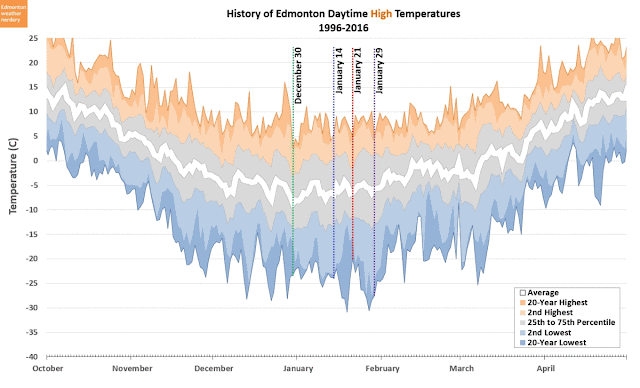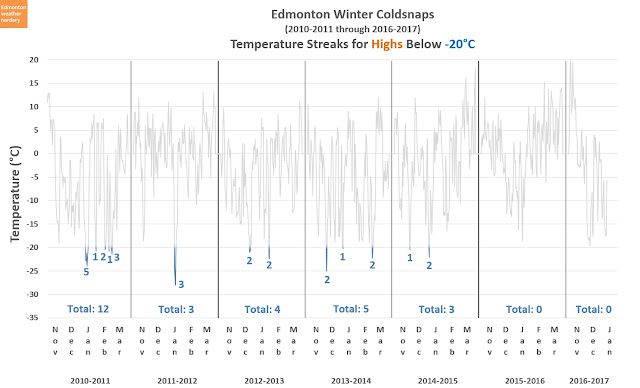The weather forecasts for this week had been warning us of a giant deepfreeze, and thankfully that didn't really happen (I like winter, but even I've got limits). It's been cold, but only pretty cold rather than
really, really cold.
Last week we looked at Edmonton's epic
26-day coldsnap from January, 1969, and today we're going to take a look at Edmonton's more recent coldsnaps - how often they happen, how long they last, and how cold it gets.
To start off with, here is a chart of daytime high temperatures for the last 6 winters:
Winter Temperatures
I wanted to go back to the winter 2010-2011 with this, because we've seen (back in this blog's
very first post) that 2010-2011 was particularly cold compared to other recent winters. We can see that a bit in this chart, with 2010-2011 having a lot of
blue for highs below freezing, compared to a warm winter like 2015-2016 which instead has a lot of
orange for all of its days above 0°C.
Looking at 2016-2017 so far, we see lots of orange during our November heatwave, but after that we've stayed below freezing more consistently than most of these other winters.
This chart has a lot going on, but today we're really just going to focus on the cold days:
Highs Below -20°C
Here's the same chart, but this time the days with High temperatures below -20°C are singled-out. I like this format because it shows how spread out or compressed the different coldsnaps are.
We can really see the difference between a cold winter like 2010-2011 which had 12 highs below -20°C, compared to a mild one like 2015-2016 which had none.
More typically, the winters from 2011-2012 through 2014-2015 all had between 3-5 Highs below -20°C. And there was one 3-day coldsnap in there, but the rest came as 1's or 2's.
For these years the two coldest Highs were January 17 2012 at -28°C, and December 6 2014 at -25°C. And so far in 2016-2017 we haven't had any Highs below -20°C, although we did come close with -19.6°C on December 10th.
Lows Below -20°C
Here we have Lows below -20°C, which is quite a bit more crowded.
I've said in the past (
here and
here) that right now we average about 23 days below -20°C each winter, and this chart gives us some idea of how that's distributed.
On the very lowend we have 2011-2012 & 2015-2016 with 10 or less, and at the highend are 2010-2011 & 2013-2014 at 40 or more. With two months left in 2016-2017 it looks like we might end up around the 23 day average, but who knows?
If we try to define a typical winter, it looks like most will have the Low drop below -20°C between 3-10 times, and when that happens it will stay there for 2-4 days.
In these last 6-and-a-bit winters the longest streak of Lows below -20°C was 9 days in January 2011, and there were also two 8-day streaks in 2012-2013 and 2013-2014. In 2016-2017 so far we've had a 6-day streak which just ended.
Lows Below -25°C
Moving on to the true deepfreezes, here we have the Lows below -25°C.
Again, 2010-2011 & 2013-2014 are the leaders, well above the other years.
And if we're looking at the "typical" winters we get about 3 of these deepfreezes, and they'll last 1, 2, or 3 days.
For these years the coldest Low was January 18, 2012 at -32.1°C (which I believe would have been my coldest-ever day riding to work). January 17-18 2012 were a two-day streak below -30°C, as were December 6-7 2014.
Right now we've gone 739 days without a -30°C which sounds impressive, but the record is 1,835 days from 1998-2003.
So that was a quick look back at the last 6-and-a-bit winters, because that is what would fit nicely on the graph. Now we're going to take a look at the very longest coldsnaps from the last 20-years. But first a reminder of 1969:
1969
As I said last week, the deepfreeze in January 1969 was epic. With 26 Highs below -21°C and 26 days with lows below -25°C there's nothing else that comes close to it in Edmonton's recorded history.
Recent Streaks with Highs Below -20°C
Here are the longest coldsnaps below -20°C going back 20 years, and they're all pretty short compared to 1969. These are the High temperatures, but I've also included the Lows as dashed lines for reference.
The longest of these coldsnaps was 12 days in January 1998, shown in
green. It doesn't really have much competition, because the next-longest are only half as long, with 6 days in January 1996 and 2004.
Those three were all from more than 10 years ago. In just the last 10 years the 5-day coldsnap in 2011 is the big winner.
One thing to mention about this chart is that the colourful background shows the average, maximum, and minimum temperatures recorded going back to 1996. Several of these coldsnaps follow that minimum temperature line pretty closely - the 1998, 2004 and 2011 coldsnaps all set quite a few of the recent records.
Recent Streaks with Lows Below -20°C, since 1996
Now we've switched to Lows, and this is actually going to be a combination of Lows below -20°C and Lows below -25°C, because the two overlap.
In the last 20 years the longest streak of Lows below -20°C was 23 days from January 3 through February 4 1996. That coldsnap also had the record-longest 8 days below -25°C, and another 5-day streak below below -25°C. We also saw this coldsnap in the previous chart, with 6 Highs below -20°C.
The second-place streak was January 1 through 15 1998 with 15 Lows below -20°C, which included two 5-day streaks below -25°C. And we also saw this coldsnap in the previous chart, with 12 Highs below -20°C.
1996 and 1998 are pretty far back, so now lets just look at the last 10 years.
Recent Streaks with Lows Below -20°C, since 2006
This is all we've got for Low temperature streaks for the last 10 years.
2008 had two 9 day streaks below -20°C: one in January and another in December. That January streak also had 6 days below -25°C, and the December one had 5 days below -25°C. Again we can see that these two streaks follow the minimum-temperature line and set several of the recent records.
2011 also had a 9-day streak below -20°C, which we saw in one of the first charts today.
Finally, lets take a look at the coldest-of-the-cold:
Days Below -30°C
In recent years, the most days we've spent below -30°C was 4, in January 1997. And again, this coldsnap set several of the recent records. This isn't much compared to the historic record though, which was 16 days below -30°C, from January 28 through February 12, 1887.
So with all of that said, none of our recent coldsnaps come close to the historic deepfreezes. We have warm winters like 2015-2016 and cold ones like 2010-2011, but in a typical winter we'll get about 3~5 coldsnaps, and they usually don't last longer than about 5 days.


















































